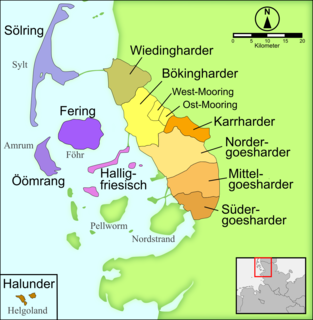 W
WNorth Frisian (nordfriisk) is a minority language of Germany, spoken by about 10,000 people in North Frisia. The language is part of the larger group of the West Germanic Frisian languages. The language comprises 10 dialects which are themselves divided into an insular and a mainland group.
 W
WEiderstedt Frisian was a dialect of the North Frisian language which was originally spoken on Eiderstedt, formerly part of the Danish Duchy of Schleswig. The Frisian language became extinct on Eiderstedt in mid-18th-Century.
 W
WFöhr Frisian, or Fering, is the dialect of North Frisian spoken on the island of Föhr in the German region of North Frisia. Fering refers to the Fering Frisian name of Föhr, Feer. Together with the Öömrang, Söl'ring, and Heligolandic dialects, it forms part of the insular group of North Frisian dialects and it is very similar to Öömrang.
 W
WGoesharde Frisian is a collective term for three of the ten dialects of the North Frisian language. Goesharde Frisian is spoken in the historical Goesharde region north of Husum. The three distinct dialects are Northern, Central and Southern Goesharde Frisian. The latter became extinct with the death of the two last speakers in 1980 and 1981 in Hattstedt. Central Goesharde Frisian is therefore now the southernmost dialect of mainland North Frisian. The most important Northern Goesharde dialects the two local varieties the villages Langenhorn and Ockholm.
 W
WHalligen Frisian is the dialect of the North Frisian language spoken on the Halligen islands, primarily Langeneß and Hooge, in the German region of North Frisia. The dialect has survived despite the islands' being home to less than 300 people and unprotected by dikes, mandating evacuations during storms. However, it is now in danger of extinction. Although it is spoken on islands, it is considered a mainland dialect due to its linguistic features.
 W
WHeligolandic (Halunder) is the dialect of the North Frisian language spoken on the German island of Heligoland in the North Sea. It is spoken today by some 500 of the island's 1,650 inhabitants and is also taught in schools. Heligolandic is closely related to the insular North Frisian dialects of Fering and Öömrang because medieval fishery around Heligoland attracted Frisians from Föhr and Amrum, and close contacts have been maintained ever since. In fact Fering and Öömrang are closer in linguistic aspects to the dialect of Heligoland than to that of their neighbouring island Sylt, Söl'ring. Heligolandic also contains a variety of loanwords from 19th-century Modern English due to the 83-year British control of the island.
 W
WKarrharde Frisian is a dialect of the North Frisian language spoken in the municipalities of Stedesand and Enge-Sande in the German Amt of Südtondern in the district of Nordfriesland, Schleswig-Holstein. It is a mainland dialect of North Frisian. The language is in danger of extinction, having a dwindling number of native speakers and no formal schooling offered to educate younger speakers.
 W
WBökingharde Frisian, also known as Mooring, is a dialect of the North Frisian language spoken in Niebüll and the amt of Bökingharde in the German region of North Frisia. The dialect forms part of the mainland group of North Frisian dialects.
 W
WWikipedia is a free multilingual open-source wiki-based online encyclopedia edited and maintained by a community of volunteer editors, started on 15 January 2001 as an English-language encyclopedia. Soon, non-English editions were created: the German and Catalan editions were created on circa 16 March, the French edition was created on 23 March, and the Swedish edition was created on 23 May. As of October 2021, Wikipedia articles have been created in 324 editions, with 313 currently active and 11 closed.
 W
WAmrum Frisian, or Öömrang, is the dialect of the North Frisian language spoken on the island of Amrum in the German region of North Frisia. Öömrang refers to the Öömrang Frisian name of Amrum, Oomram. Together with the Fering, Söl'ring, and Heligolandic dialects, it forms part of the insular group of North Frisian dialects and it is very similar to Fering. Öömrang is spoken by about one third of Amrum's 2300 people.
 W
WSylt Frisian, or Söl'ring, is the dialect of the North Frisian language spoken on the island of Sylt in the German region of North Frisia. Söl'ring refers to the Söl'ring Frisian word for Sylt, Söl'. Together with the Fering, Öömrang, and Heligolandic dialects, it forms part of the insular group of North Frisian dialects. It differs from the mainland dialects because of its relatively strong Danish influence. Due to mass tourism on Sylt, the dialect has been largely displaced by forms of German and Söl'ring is spoken only by a few hundred people, many of whom no longer reside on Sylt. Although it is taught in several primary schools, its prospects for survival are unfavorable compared with other insular dialects.
 W
WWiedingharde Frisian is a dialect of the North Frisian language spoken in the German amt of Wiedingharde south of the border to Denmark in North Frisia. The dialect forms part of the mainland group of North Frisian dialects. Although it is spoken adjacent to Mooring-speaking Bökingharde, it has more in common with Goesharde Frisian. Like the insular Söl'ring dialect, Wiedingharde Frisian shows influence from Danish and South Jutlandic.